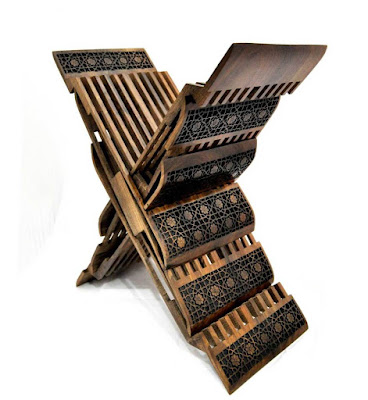 |
| Nine-tiered Uzbek bookstand |
It should be pointed out that not every craftsman is capable of making a lauh even if he can make remarkable boxes, tables, chandeliers, screens, doors and furniture.
The making of a lauh requires the utmost wood-carving craftsmanship. One has to have a special attitude of mind and virtuosic carving skills.
The construction of a lauh is based on accurate mathematical calculations and meticulously adjusted lines, angles and bends. A slightly inaccurate movement of the chisel or the handsaw – and all efforts will "go to the dogs".
This cannot be allowed because the piece of wood has passed through a very lengthy pre-treatment before it came to the woodcarver. Therefore, there should be no fuss or haste, only patience and composure.
Hardwood such as that from walnut and plane trees is used for making lauhs. In order for the book rest to remain durable for many years and to prevent it from deformation and cracking, the wood should be properly pre-treated.
The patterns on wood are more beautiful and clear if logs are soaked in special water reservoirs for a whole year. During that period of time, colorants penetrate from the bark into the smallest pores of the wood. The older the tree, the nobler the hues.
Later, boards 50-60 mm thick made from these logs are placed in stacks with gaps between them and dried for between 8 and 10 years in a dry, dark and well-ventilated room, with regular overturning.
A craftsman can judge the readiness of wood by knocking on its surface with his knuckles. When a board is finally ready, a bar of the required dimensions is sawn from it, and the mystery of making a lauh begins.
 |
| Carved mini Uzbek book stand |
When a lauh is ready, it is thoroughly polished. The craftsmen entrust this operation to their apprentices.
It turns out that wood-carvers and wood-painters, like musicians, have their own training techniques.
Craftsmen have design albums. They are filled with rows of patterns, the so-called “simple flower". Apprentices draw the same pattern until all lines coincide when sheets are superimposed one onto another.
Then they start drawing another pattern. There are twelve of them, each more difficult than the previous one. With time, every craftsman develops his own unique style. Probably, for this reason, wood-carvers never put their identification marks onto the articles they make. Each craftsman is recognized thanks to his own style.
Despite the diversity of individual styles, the Uzbek school of wood-carving cannot be mistaken for any other . The most convincing proof is the unique Uzbek lauh highly appreciated not only by tourists visiting Uzbekistan but also by the most sophisticated connoisseurs of national handicrafts.
If you have a lauh and have forgotten how to make the various positions, here is a 22-second video to jog your memory. [If this does not appear on your device, please visit this link directly: https://www.youtube.com/watch?v=utyqtW849WM]
Source: This article, written by Galina Yudina, was first published in Uzbek Airways in-flight magazine.
Related posts:
A Glimpse of Khivan Woodcarving 1937
Chekichs: Uzbek Bread Stamps
Lauh - A Wooden Wonder of Uzbekistan, Part #1